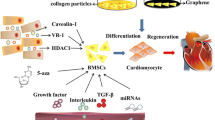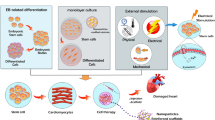Abstract
We have isolated a cardiomyogenic cell line (CMG cell) from murine bone marrow mesenchymal stem cells. The cells showed a fibroblast-like morphology, but the morphology changed after 5-azacytidine exposure. They began spontaneous beating after 2 weeks, and expressed ANP and BNP. Electron microscopy revealed a cardiomyocyte-like ultrastructure. These cells had several types of action potentials; sinus node-like and ventricular cell-like action potentials. The isoform of contractile protein genes indicated that their muscle phenotype was similar to fetal ventricular cardiomyocytes. They expressed α1A, α1B, α1D, β1, and β2 adrenergic and M1 and M2 muscarinic receptors. Stimulation with phenylephrine, isoproterenol and carbachol increased ERK phosphorylation and second messengers. Isoproterenol increased the beating rate, which was blocked with CGP20712A (β1-selective blocker). These findings indicated that cell transplantation therapy for the patients with heart failure might possibly be achieved using the regenerated cardiomyocytes from autologous bone marrow cells in the near future.
Similar content being viewed by others
References
Alonso-Llamazares A, Zamanillo D, Casanova E, Ovalle S, Calvo P & Chinchetru MA (1995) Molecular cloning of alpha 1dadrenergic receptor and tissue distribution of three alpha 1-adrenergic receptor subtypes in mouse. J Neurochem 65: 2387–2392.
Arceci RJ, King AA, Simon MC, Orkin SH & Wilson DB (1993) Mouse GATA-4: A retinoic acid-inducible GATA-binding transcription factor expressed in endodermally derived tissues and heart. Mol Cell Biol 13: 2235–2246.
Ashton BA, Allen TD, Howlett CR, Eaglesom CC, Hattori A & Owen M (1980) Formation of bone and cartilage by marrow stromal cells in diffusion chambers in vivo. Clin Orthop 151: 294–307.
Berstein G, Blank JL, Smrcka AV, Higashijima T, Sternweis PC, Exton JH & Ross EM (1992) Reconstitution of agonist-stimulated phosphatidylinositol 4,5-bisphosphate hydrolysis using purified m1 muscarinic receptor, Gq/11, and phospholipase C-beta 1. J Biol Chem 267: 8081–8088.
Chen Z, Friedrich GA & Soriano P (1994) Transcriptional enhancer factor 1 disruption by a retroviral gene trap leads to heart defects and embryonic lethality in mice. Genes Dev 8: 2293–2301.
Delcarpio JB & Claycomb WC (1997) Cardiomyocyte transfer into the mammalian heart. Cell-to-cell interactions in vivo and in vitro. Ann NY Acad Sci 52: 267–285.
Edmondson DG, Lyons GE, Martin JF & Olson EN (1994) Mef2 gene expression marks the cardiac and skeletal muscle lineages during mouse embryogenesis. Development 120: 1251–1263.
Ferrari G, Angelis GC, Colleta M, Paolucci E, Stornaiolo A, Cossu G & Mavilio F (1998) Muscle regeneration by bone marrowderived myogenic progenitors. Science 279: 1528–1530.
Friedenstein AJ, Chailakhyan R & Gerasimov UV (1987) Bone marrow osteogenic stem cells: In vitro cultivation and transplantation in diffusion chambers. Cell Tissue Kinet 20: 263–272.
Fukuda K (2001) Development of regenerative cardiomyocytes from mesenchymal stem cells for cardiovascular tissue engineering. Artif Organs 25: 183–193.
Hakuno D, Fukuda K, Makino S, Konishi F, Tomitra Y, Manabe T, Suzuki Y, Hisaka Y, Umezawa A & Ogawa S (2002) Bone marrow-derived cardiomyocytes (CMG cell) expressed functionally active adrenergic and muscarinic receptors. Circulation 105: 380–386.
Kocher AA, Schuster MD, Szabolcs MJ, Takuma S, Burkhoff D, Wang J, Homma S, Edwards NM & Itescu S (2001) Neovascularization of ischemic myocardium by human bone-marrowderived angioblasts prevents cardiomyocyte apoptosis, reduces remodeling and improves cardiac function. Nat Med 7: 430–436.
Linnets TJ, Parsons LM, Harley L, Lyons I & Harvey RP (1993) Nkx-2.5: A novel murine homeboy gene expressed in early heart progenitor cells and their myogenic descendants. Development 119: 419–431.
Makino S, Fukuda K, Miyoshi S, Konishi F, Kodama H, Pan J, Sano M, Takahashi T, Hori S, Abe H, Hata J, Umezawa A & Ogawa S, (1999) Cardiomyocytes can be generated from marrow stromal cells in vitro. J Clin Invest 103: 697–705.
Nakamura F, Kato M, Kameyama K, Nukada T, Haga T, Kato H, Takenawa T & Kikkawa U (1995) Characterization of Gq family G proteins GL1 alpha (G14 alpha), GL2 alpha (G11 alpha), and Gq alpha expressed in the baculovirus-insect cell system. J Biol Chem 270: 6246–6253.
Prockop DJ (1997) Marrow stromal cells as stem cells for nonhematopoietic tissues. Science 276: 71–74.
Rickard DJ, Sullivan TA, Shenker BJ, Leboy PS & Kazhdan I (1994) Induction of rapid osteoblast differentiation in rat bone marrow stromal cell cultures by dexamethasone and BMP-2. Dev Biol 161: 218–228.
Rockman HA, Koch WJ & Lefkowitz RJ (1997) Cardiac function in genetically engineered mice with altered adrenergic receptor signaling. Am J Physiol 272: H1553–H1559.
Rokosh DG, Stewart AF, Chang KC, Bailey BA, Karliner JS, Camacho SA, Long CS & Simpson PC (1996) Alpha1-adrenergic receptor subtype mRNAs are differentially regulated by alpha1-adrenergic and other hypertrophic stimuli in cardiac myocytes in culture and in vivo. Repression of alpha1B and alpha1D but induction of alpha1C. J Biol Chem 271: 5839–5843.
Roy NS, Wang S, Jiang L, Kang J, Benraiss A, Harrison-Restelli C, Fraser RA, Couldwell WT, Kawaguchi A, Okano H, Nedergaard M & Goldman SA (2000) In vitro neurogenesis by progenitor cells isolated from the adult human hippocampus. Nat Med 6: 271–277.
Sharma VK, Colecraft HM, Rubin LE, Sheu SS (1997) Does mammalian heart contain only the M2 muscarinic receptor subtype? Life Sci 60: 1023–1029.
Shimizu K, Sugiyama S, Aikawa M, Fukumoto Y, Rabkin E, Libby P & Mitchell RN (2001) Host bone-marrow cells are a source of donor intimal smooth-muscle-like cells in murine aortic transplant arteriopathy. Nat Med 7: 738–741.
Soonpaa MH, Koh GY, Klug MG & Field LJ (1997) Formation of nascent intercalated disks between grafted fetal cardiomyocytes and host myocardium. Science 264: 98–101.
Stewart AF, Rokosh DG, Bailey BA, Karns LR, Chang KC, Long CS, Kariya K & Simpson PC (1994) Cloning of the rat alpha 1Cadrenergic receptor from cardiac myocytes. alpha 1C, alpha 1B, and alpha 1D mRNAs are present in cardiac myocytes but not in cardiac fibroblasts. Circ Res 75: 796–802.
Wobus AM, Wallukat G & Hescheler J (1991) Pluripotent mouse embryonic stem cells are able to differentiate into cardiomyocytes expressing chronotropic responses to adrenergic and cholinergic agents and Ca2+ channel blockers. Differentiation 48: 173–182.
Wobus AM, Kleppisch T, Maltsev V & Hescheler J (1994) Cardiomyocyte-like cells differentiated in vitro from embryonic carcinoma cells P19 are characterized by functional expression of adrenoceptors and Ca2+ channels. In Vitro Cell Dev Biol Anim 30: 425–434.
Yasui K, Liu W, Opthof T, Kada K, Lee JK, Kamiya K & Kodama I (2001) I(f) current and spontaneous activity in mouse embryonic ventricular myocytes. Circ Res 88: 536–542.
Author information
Authors and Affiliations
Rights and permissions
About this article
Cite this article
Fukuda, K. Regeneration of cardiomyocytes from bone marrow: Use of mesenchymal stem cell for cardiovascular tissue engineering. Cytotechnology 41, 165–175 (2003). https://doi.org/10.1023/A:1024882908173
Issue Date:
DOI: https://doi.org/10.1023/A:1024882908173




